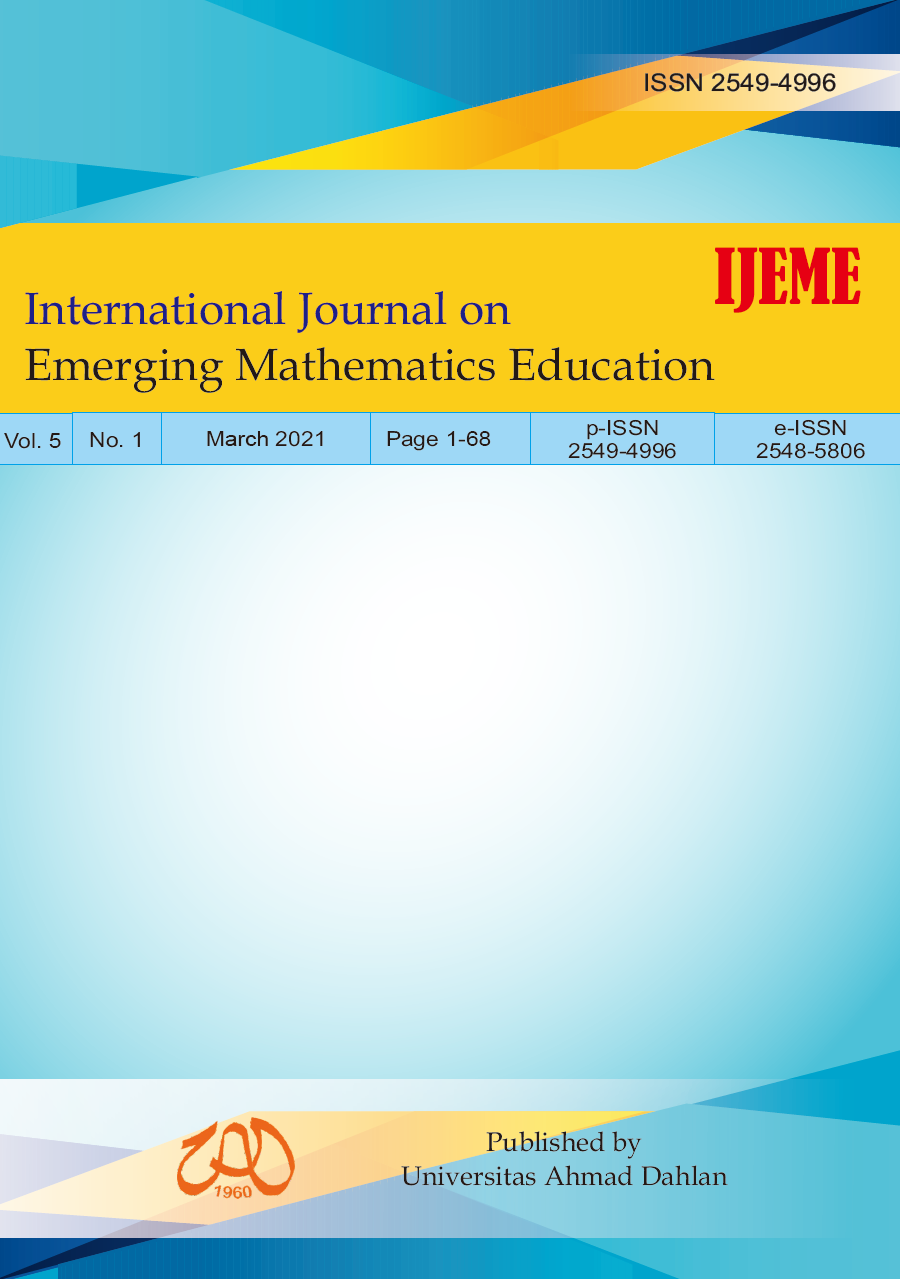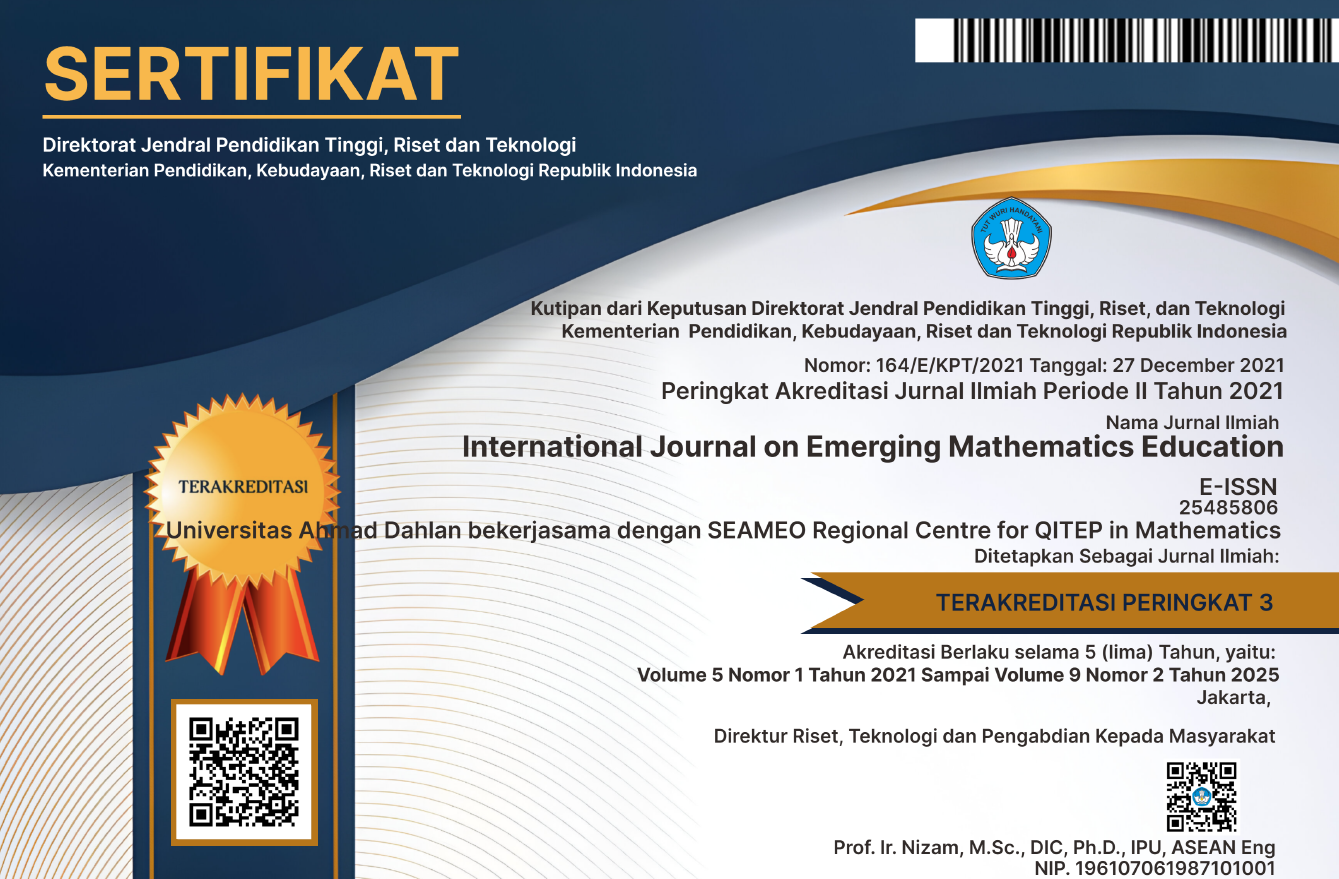Mathematical Probabilistic Thinking Process Stages in Problems Solving Probability
DOI:
https://doi.org/10.12928/ijeme.v5i1.20005Keywords:
higher order thinking skills, probabilistic thinking stages, problem-solvingAbstract
Probabilistic thinking is one type of thinking skills which belongs to the Higher Order Thinking Skills (HOTS). Students need to have the probabilistic thinking ability to face the life which is full of uncertainty. The purpose of this research is to formulate the stages of mathematical probabilistic thinking processes in solving probability problems. It was a descriptive qualitative research involving eight students of the 9th grade of SMP Muhammadiyah 3 Mlati Sleman Yogyakarta as the subjects. We administered a probabilistic thinking test and then observed and interviewed them to get the data. The data were then analyzed using triangulation method. This study resulted the five stages of mathematical probabilistic thinking process. They are: (1) understanding the problem of uncertainty that needs to be solved; (2) identifying all possibilities that will occur from a problem; (3) grouping the results of the identified event; (4) determining the probability of the occurred events; and (5) verifying the results.References
Aseeri, M. M. Y. (2020). Abstract thinking of practicum students at Najran University in light of Piaget's theory and its relation to their academic level. Journal of Curriculum and Teaching, 9(1), 63-72.
Borovcnik, M. (2016). Probabilistic thinking and probability literacy in the context of risk Pensamento probabilístico e alfabetização em probabilidade no contexto do risco. Educação Matemática Pesquisa: Revista do Programa de Estudos Pós-Graduados em Educação Matemática, 18(3).
Chernoff, E. J., & Sriraman, B. (2014). Probabilistic thinking: presenting plural perspectives. New York: Springer.
Creswell, J. W. (2014). Research Design: Qualitative, Quantitative, and Mixed Method Approaches. SAGE Publishing.
Facione, P. A., & Facione, N. C. (2013). Critical thinking for life: Valuing, measuring, and training critical thinking in all its forms. Inquiry: Critical Thinking Across the Disciplines, 28(1), 5-25.
Jan, I., & Amit, M. (2009). A four phase model for predicting the probabilistic situation of compound events. Beersheba: Ben Gurion University.
Jones, G. A., Langrall, C. W., Thornton, C. A., & Mogill, A. T. (1997). A framework for assessing and nurturing young children's thinking in probability. Educational Studies in Mathematics, 32(2), 101-125.
Jones, G. A., Langrall, C. W., Thornton, C. A., & Mogill, A. T. (1999). Students' probabilistic thinking in instruction. Journal for Research in Mathematics Education, 487-519.
Krulik, S., & Rudnick, J. A. (1996). The new sourcebook for teaching reasoning and problem solving in junior and senior high school. Allyn & Bacon.
Mason, J., Burton, L., & Stacey, K. (2010). Thinking mathematically. Pearson Education.
Moleong, L. J. (2015). Metodologi Penelitian Kualitatif. Bandung: Remaja Rosdakarya.
Nacarato, A. M., & Grando, R. C. (2014). The role of language in building probabilistic thinking. Statistics Education Research Journal, 13(2), 93-103.
Perkins, C., & Murphy, E. (2006). Identifying and measuring individual engagement in critical thinking in online discussions: An exploratory case study. Journal of Educational Technology & Society, 9(1), 298-307.
Polaki, M. V. (2002). Assessing and tracing the development of Basotho elementary students' growth in probabilistic thinking. In Proceedings of the Sixth International Conference on Teaching Statistics (ICOTS 6). Lesotho: National University of Lesotho.
Polya, G. (1971). How to Solve It: A New Aspect of Mathematics Method. New Jersey: Princeton University Press.
Sadler-Smith, E. (2015). Wallas four-stage model of the creative process: More than meets the eye? Creativity Research Journal, 27(4), 342-352.
Satchakett, N., & Art-in, S. (2014). Development of Heuristics Problem Solving, and learning achievement of grade 9 students by using learning management focusing on Heuristics Approach in Thailand. Procedia-Social and Behavioral Sciences, 116, 1011-1015.
Stacey, K., Burton, L., & Mason, J. (1982). Thinking mathematically. Addison-Wesley.
Sujadi, I. (2008). Rekonstruksi Tingkat-Tingkat Berpikir Probabilistik Siswa Sekolah Menengah Pertama. In Proceeding Seminar Matematika dan Pendidikan Matematika. FKIP UNS.
Watson, G. (1980). Watson-Glaser critical thinking appraisal. San Antonio, TX: Psychological Corporation.
Downloads
Published
How to Cite
Issue
Section
License
License and Copyright Agreement
In submitting the manuscript to the journal, the authors certify that:
- They are authorized by their co-authors to enter into these arrangements.
- The work described has not been formally published before, except in the form of an abstract or as part of a published lecture, review, thesis, or overlay journal. Please also carefully read the International Journal on Emerging Mathematics Education (IJEME) Author Guidelines at http://journal.uad.ac.id/index.php/IJEME/about/submissions#authorGuidelines
- That it is not under consideration for publication elsewhere,
- That its publication has been approved by all the author(s) and by the responsible authorities, tacitly or explicitly, of the institutes where the work has been carried out.
- They secure the right to reproduce any material that has already been published or copyrighted elsewhere.
- They agree to the following license and copyright agreement.
Copyright
Authors who publish with the International Journal on Emerging Mathematics Education (IJEME) agree to the following terms:
- Authors retain copyright and grant the journal the right of first publication with the work simultaneously licensed under a Creative Commons Attribution License (CC BY-SA 4.0) that allows others to share the work with an acknowledgment of the work's authorship and initial publication in this journal.
- Authors are able to enter into separate, additional contractual arrangements for the non-exclusive distribution of the journal's published version of the work (e.g., post it to an institutional repository or publish it in a book), with an acknowledgment of its initial publication in this journal.
- Authors are permitted and encouraged to post their work online (e.g., in institutional repositories or on their website) prior to and during the submission process, as it can lead to productive exchanges, as well as earlier and greater citation of published work.
![]()
Ciptaan disebarluaskan di bawah Lisensi Creative Commons Atribusi-BerbagiSerupa 4.0 Internasional.





